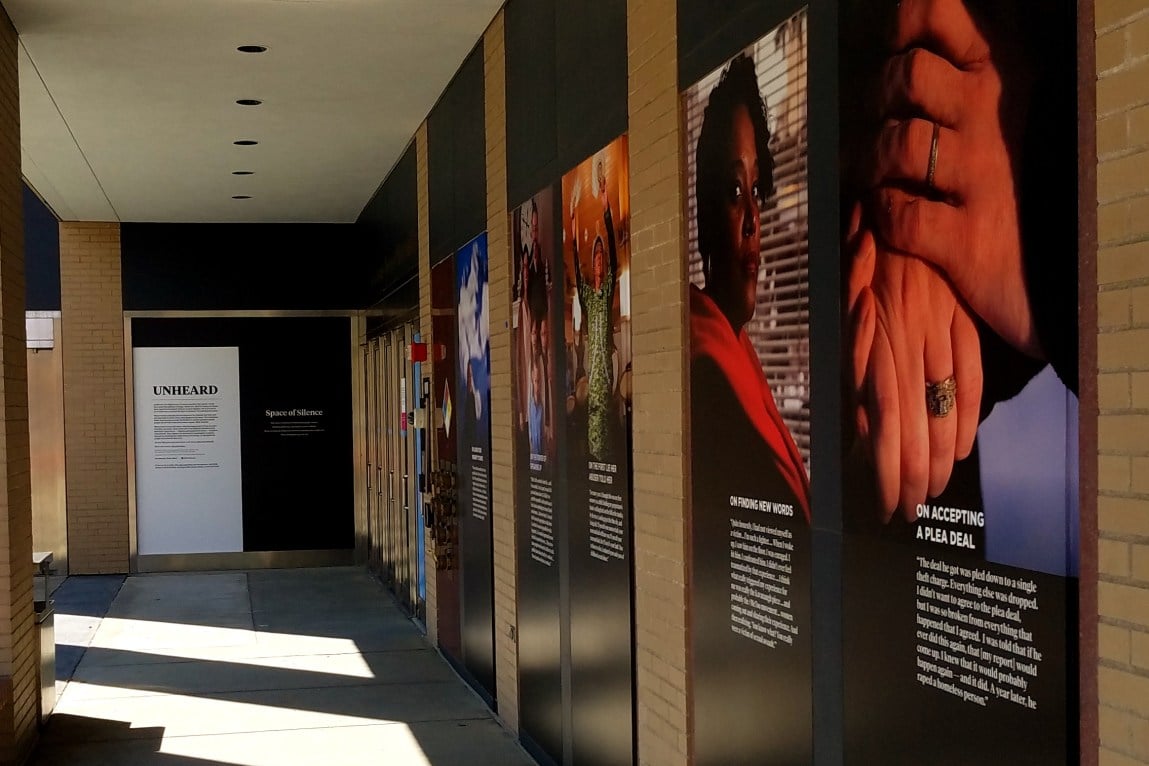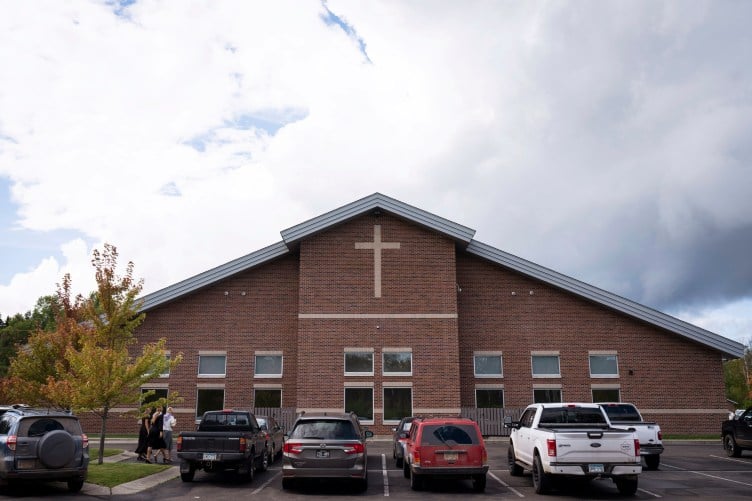Over the past year, the reporting teams at the Anchorage Daily News and ProPublica have explored Alaska’s high rate of sexual assault and have worked to bring attention to the survivors who have gone unheard. On Wednesday, we’ll add another medium to the collection: an outdoor installation at the Anchorage Museum.
The installation launches at the close of a monthlong project about 29 survivors who chose to speak about what happened to them. Each day in June, we published a portrait and a story of a survivor of sexual assault on the front page of the paper. All of the participants worked closely with Daily News photographers to create a portrait true to them. (We wrote about that process in this essay.) These individual features culminate Wednesday with a “space of silence” dedicated to those who are not yet ready to share their stories.
Museum Director and CEO Julie Decker says she believes the museum’s platforms are another way to support people telling their own stories, in their own voices: “Change comes through awareness and understanding. Without the stories, there is silence.”
The portraits will be displayed as large vinyl posters on the museum’s outdoor facade, where passersby can see them, even in the middle of a pandemic when the museum has reopened but with limited capacity inside. Occupying 27 9-foot panels along the museum’s wall, the photography installation also includes recorded audio from many of the people featured, literally making their voices heard. It will remain on view through mid-September. The museum sits on a busy and accessible downtown street, which will allow the public to encounter the work as public art.
To learn more about the process to transform “Unheard” into public art, we spoke to Decker and Chief Design Officer Jonny Hayes. Marie Sakar, one of the 27 people whose profiles are on display, shared why she’s participating.
Some quotes have been condensed and edited for clarity.
Julie Decker, director and CEO
Why did you think that this project had the potential to become a museum installation?
It’s a difficult issue, but examining why things aren’t getting better for sexual assault survivors is partly about listening, understanding power and recognizing both the power of and lack of power in silence. The installation is part of listening to people’s stories and about supporting the idea of people telling their own stories, in their own voice. We also wanted to help recognize the Pulitzer Prize-winning work of the Anchorage Daily News and ProPublica and journalism as a public service. Museums are part of reflecting the voices of a community. It’s an important time for voices to be heard.
What do you hope people will take from this?
The victims are not defined only by the violence against them. For other victims, we hope part of the message is that they are not alone.
What special considerations did you take into account, given the intensely personal nature of the content and the public installation?
We want to be mindful of the difficulty of the topic and wanted to take care with placement, message and making sure that part of the text was information about who to call if you’re in crisis and ways for other victims to tell their own stories.

Jonny Hayes, chief design officer
How does the exterior installation build upon the “Unheard” project?
By increasing the size and elevating the portraits within the space itself, each of the participants’ narratives is intended to communicate the individuals’ sense of being heard in an urban context, visually. A key aspect of the entire project and its methodology was to empower the narrators, and so establishing that relationship in a physical space made a lot of sense.
What do you have to do to make an ambitious project like this work?
The outdoor installation came together quickly and with so much work done by the journalists and publication teams. For an installation that means designating the right space to facilitate the content and fully evaluate existing assets (power, light, surfaces, etc.) so that the installation can work as a series of systems. As the project needed to conform to the set publication timeline, the design and space had to be thoroughly measured, evaluated, digitally generated and content incorporated as part of the selection and review process. The sensitivity of “Unheard” subject matter meant that there were additional layers of coordination and cohesion across the multiple platforms being delivered. The visuals were developed in tandem with other designers’ aesthetics to appear consistent and complementary to the publication teams’ efforts while standing on its own in a unique space.
Tell us about the panels and the audio.
The outdoor installation consists of 27 individual participant stories set on a series of walls stretching about 150 linear feet. [They are] set back in a colonnade along the south facade of the Anchorage Museum and adjacent to a pedestrian area on Seventh Avenue. Each individual panel is about 9 feet tall by 4 feet wide. The portrait is placed slightly above eye height with a color-block base that includes text that is legible from a few feet away so visitors can connect to the stories at various distances. Once visitors enter into the colonnade, they are greeted with audio statements by participants who opted to be recorded. A large title panel describing the project is placed immediately adjacent to the Museum entry and is accompanied by a space of silence, recognizing those who are unable to share their story, with a link to resources for those in crisis. The portraits and text are designed to be the primary points of focus with all supporting elements developed to create a setting that is personal, feels quiet and integrated into the environment for a sense of belonging.

Marie Sakar, 48, is an elementary school teacher and mother who lives in her home village of Chuathbaluk, on the Kuskokwim River. Her story and portrait were featured in the “Unheard” project.
How has having your story published impacted your life?
It has a sense of freedom. I shared it with family members, elders, young girls and boys in my village who have no internet access, and got unexpected affirmation, confirmation and appreciation for being so brave to share my story.
What made you want to participate in the Anchorage Museum installation?
After all the years of being invisible, it gives me a sense of finally being seen, and heard. I’m not afraid to tell my story anymore. I have finally come out of the darkness.
What made you decide to participate in the “Unheard” project?
I made the decision to participate in the “Unheard” project because the judicial system let me down. When I finally did say something, I was told, “The statute of limitations has already passed.” Many of the perpetrators who violated my mind and my body are still walking free, and have hurt other girls and women the same way they hurt me. If they have the audacity to realize that one of their victims is speaking up, maybe, just maybe, they’ll think twice about their actions.
What do you hope people who see these portraits learn or come away with?
It’s OK to tell your story. People will still love, honor, respect and accept you regardless of what atrocities happened to you.
Read our collection of stories from survivors who chose to speak.
For more on resources for survivors visit adn.com/crisis*. *
On Friday, July 10, at 12 p.m. AKDT/4 p.m. EDT, join Anchorage Daily News and ProPublica for a digital event with members of the reporting team, an advocate who works with survivors of sexual assault in Alaska and a person who chose to share their story in “Unheard.” They’ll speak about how they brought this careful and collaborative reporting to light and the impact spurred by the project. Register here.


















